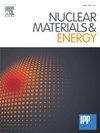A new design concept of actively cooled plasma-facing units for the divertors of fusion reactors
IF 2.3
2区 物理与天体物理
Q1 NUCLEAR SCIENCE & TECHNOLOGY
引用次数: 0
Abstract
This paper sketches a new divertor design concept that solves most of the issues already identified with the actual ITER design, especially in what concerns transient heat loading. It resists ELM heat loads better than the present ITER design. This alternative design, consisting of tubes running approximately along the magnetic field direction, simultaneously eliminates sharp toroidal edges of tungsten monoblocks that will melt, and optical hot spots that could melt or vaporize in ITER if ELMs are present. Steady state, inter-ELM divertor surface temperatures will not be higher than in ITER for identical plasma irradiation conditions. The design is just as resilient as ITER’s with respect to critical heat flux in the cooling tubes. Knowing that simple tubes might not be appropriate for a divertor design in a fusion reactor, we also discuss the possibility of bonding conical tungsten “beads” to the cooling tubes. The expected differences between the simple tube model and the one with tungsten beads will be discussed.
求助全文
约1分钟内获得全文
求助全文
来源期刊

Nuclear Materials and Energy
Materials Science-Materials Science (miscellaneous)
CiteScore
3.70
自引率
15.40%
发文量
175
审稿时长
20 weeks
期刊介绍:
The open-access journal Nuclear Materials and Energy is devoted to the growing field of research for material application in the production of nuclear energy. Nuclear Materials and Energy publishes original research articles of up to 6 pages in length.
 求助内容:
求助内容: 应助结果提醒方式:
应助结果提醒方式:


